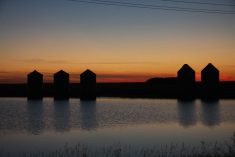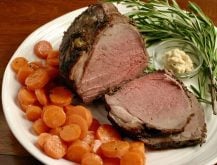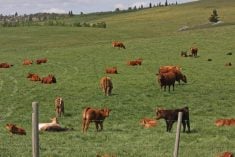OAKBANK, Man. – Jim Lintott moves rapidly from task to task, barely staying long enough in one place to leave a footprint in the snow as he cuts twine and spreads bales for his herd of Black Angus cattle on a sunny, windless day in March.
While his movement is surprising to a visitor, the cattle on this southern Manitoba pasture seem accustomed to the perpetual motion. Hauling out another bale with a Bobcat, the cows clear a path.
The urge to keep moving and get things done has likely helped Lintott in his career on the farm. Since his first foray into agriculture 35 years ago, he has had leafcutter bees, operated a custom pollinating service, sold alfalfa seed, produced high quality hay for horses, grown oilseeds and grains and is now producing grass-fed beef.
Read Also

Know what costs are involved in keeping crops in the bin
When you’re looking at full bins and rising calf prices, the human reflex is to hold on and hope for more. That’s not a plan. It’s a bet. Storage has a price tag.
Since the early 1990s, home base for all that activity has been the Oakbank, Man., farm where Lintott lives with his wife Carolyn and their three dogs.
He was raised in Winnipeg and Carolyn grew up in Hamilton, Ont.
“I grew up above a juke box store in downtown Hamilton, not even a backyard,” said Carolyn.
Lintott said his childhood helped pre-pare him for a career in agriculture.
“I had a paper route. I had the crummiest paper route … I had 11 papers on a three-mile route. So I (got) used to dealing with cold weather, long distances and low wages.”
Lintott’s introduction to agriculture began while studying zoology and botany at the University of Manitoba in the 1970s.
He was a summer student with Cameron Jay, an entomology professor, and worked on a leafcutter bee program. The relationship with the professor led to Lintott spending a year in Kenya on a pollination project.
When he returned, he created a colony of leafcutter bees in an old garage in Winnipeg for a custom pollinating business serving farmers in Manitoba’s Interlake.
As the business expanded, Lintott needed more space and bought his current farm. Through his work with leafcutters, he developed a connection with what is now the Manitoba Forage Seed Association.
He began growing his own alfalfa seed and became a part owner of North Star Seeds, a grass and legume seed company in Neepawa.
He expanded into growing cereal crops and oilseeds, growing hay for the horse market and raising cattle. He and Carolyn no longer have bees but his goal is to run a small diversified and self-sufficient farm on 1,000 acres of rented land.
“To grow everything. To go from a pound of seed, use the seed to grow the crops to produce the beef and (then) market the beef,” he said.
Now retired from her job as assistant superintendent in a school division, Carolyn’s role on the farm is providing help wherever and whenever it’s needed.
She helps Lintott move cattle from pasture to pasture, runs the baler during haying season and does all the books for their farm.
For the last few years, the focus on the Lintott farm has been producing grass-fed beef and selling the product directly to consumers.
When they had a surplus of hay in 2001, Lintott and five other partners started a joint cattle herd. They recently converted the herd into a grass-fed operation on the advice of forage specialist Fraser Stewart.
Stewart, who is now retired, be-lieved there was an opportunity in Manitoba to finish cattle on the rich forages in the province. But to finish cattle on grass, producers need a herd with the right genetics, he said.
“They (the feedlot industry) like to have these larger animals and it is more difficult to finish those animals on high forage diets,” Stewart said.
That means grass-fed producers need smaller to medium sized animals, finishing at 1,000 to 1,100 pounds.
Lintott admitted it has been a challenge to build a herd of animals that consistently finish and produce high quality grass-fed beef.
On the demand side, the Lintotts have been selling the grass-fed beef at a farmer’s market in Winnipeg and they’re slowly building up a base of loyal customers.
The challenge is figuring out how to sell the non-prime cuts.
“We’ve had some good interest from restaurants … but they only want the high end cuts,” Carolyn said.
To solve that problem, Lintott and the others in the Manitoba Grass-fed Beef Producers Association are developing a high-end sausage filled with grass-fed beef, wine and saskatoons.
Despite the production and marketing challenges, Lintott has plans to keep moving forward, processing the sausage at a federally inspected plant in Manitoba and selling the product out west.
“We’re focusing on cutting our teeth in Manitoba, making our mistakes here … we’re really focusing on coming up with a product that we can take to Vancouver … we know Vancouver is a market that we can survive in.”















